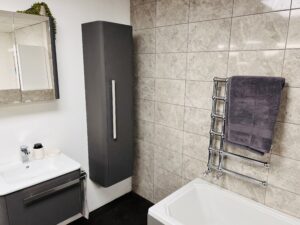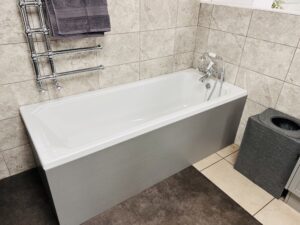Is it better to have porcelain or ceramic tiles?
At the end of the day, the bathroom is a place that is bound to get wet sometimes very wet and therefore, non-waterproof flooring, like carpet and real wooden floors, are often disregarded (and with complete sense!) when choosing a bathroom surface.
Now we’ve established that tiles work best in a bathroom in comparison to other types of floors, let’s answer all the question of which type of tile is the best for use in a bathroom?

When choosing the type of tile to install in your bathroom, you should consider a few different options.
Important! Consider the following when choosing your bathroom tiles:
- Quality of tiles…
- What is the tile’s vitreosity?
This is less about the price and quality of the tile material, however, more about the fact that you should be using tiles that WILL NOT absorb water in wet areas.
Vitreous tiles do not absorb water and are ideal for outdoor areas and for use in bathrooms. Ultimately, if the tiles are not vitreous you’d be best to install them in dryer areas of the household where water won’t puddle.
If you don’t understand vitreosity, we’re about to tell you more.
What does vitreous mean?
Vitreous essentially means that the bathroom tile has been glazed so that it has an absorption rate of equal to, or less than 7 percent. This means that in most cases, the tiles are frost-proof (completely ample for a bathroom then, of course!).
When looking at ‘Vitreosity’ in detail, you can separate it into the following categories:
- Non-vitreous tiles: Non-vitreous tiles offer a low density and have a water absorption of more than 7%
- Semi-vitreous tiles: Semi-vitreous tiles have a water absorption of over 3% and less than 7%.
- Vitreous tiles: Vitreous tiles offer a higher density and have a water absorption of over 0.5% but less than 3%.
- Impervious tiles: Impervious tiles are extremely dense, with a water absorption of 0.5% or less. This is where good porcelain tiles for bathroom use are generally categorized.
Bet you’re now wondering what types of tiles are vitreous and therefore, suitable for a bathroom.
The following types of tile can be used in a bathroom:
Glazed ceramic or porcelain tiles

Porcelain tiles are generally impervious when they have been glazed and are, therefore, ideal for use in bathrooms.
Glass Tiles
Glass tiles have a clean, hygienic look and feel. They are easy to wipe over after use and popular in modern homes. They are best used on the walls or low-traffic areas of the floor. Tiles make a great option for a feature wall.
Quarry Tiles
Quarry tiles can be semi-vitreous or vitreous, so make sure you investigate the type of tile you are buying. The more vitreous the tile for a bathroom, the better.
Natural Stone Tiles
Natural stone tiles have a rustic and modern aesthetic. While they generally withstand water well when used in a bathroom, they will need a waterproof membrane applied beneath them as they are not completely waterproof
Types of Natural Stone:
Marble: Marble originates from limestone and can be treated for use in bathrooms. Marble is favoured for its interesting colours and patterns when used in a bathroom.
Granite: Granite is harder than other tiles and is often used in areas of high-traffic on the floor.
Slate: The great thing about slate is the fact that it is slip-resistant and, therefore, a popular tile for use on the floors.
Limestone: Limestone tiling is suitable for use on the floors of a bathroom. When light in appearance, limestone makes great floor tiles for small toilet rooms, making the room light, airy and spacious.
Next you’ll also want to consider the bathroom wall tile sizes
If you have a large bathroom, you could opt for larger tiles across the whole of your wall and floor space. Smaller tiles, such as mosaic tiles, tend to work best on feature walls or in smaller bathrooms.